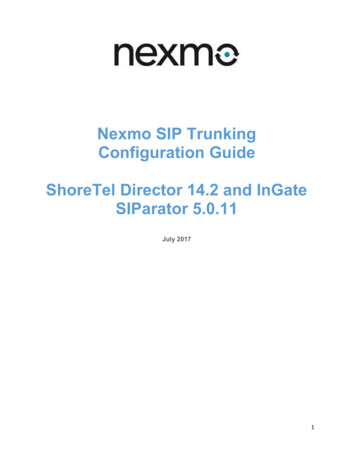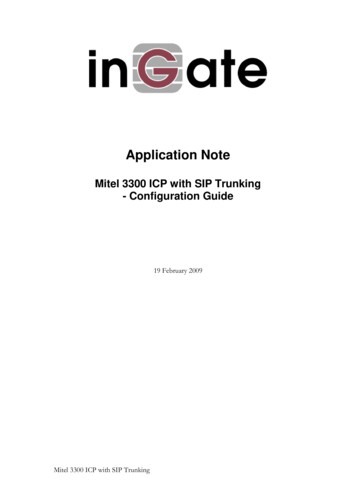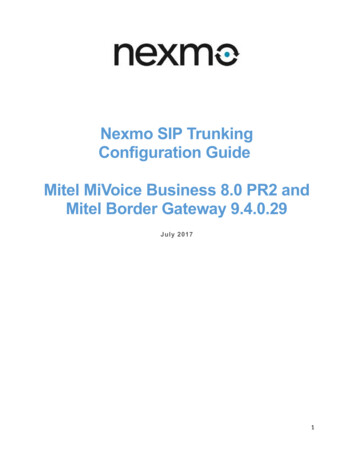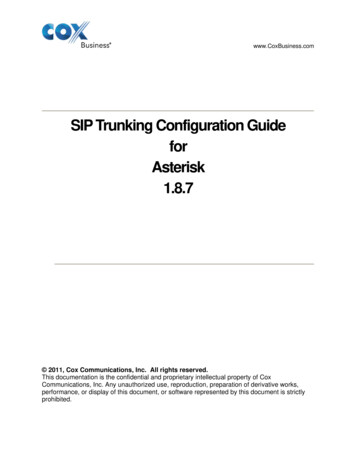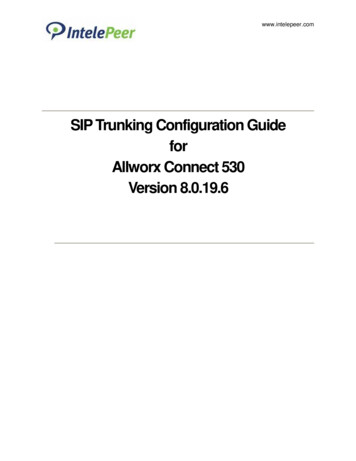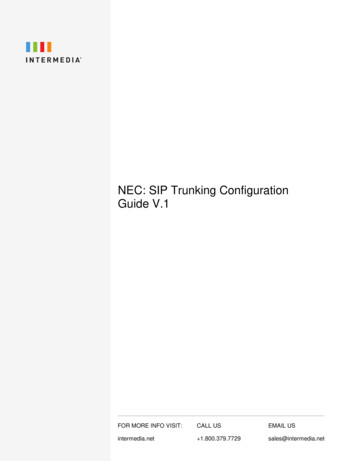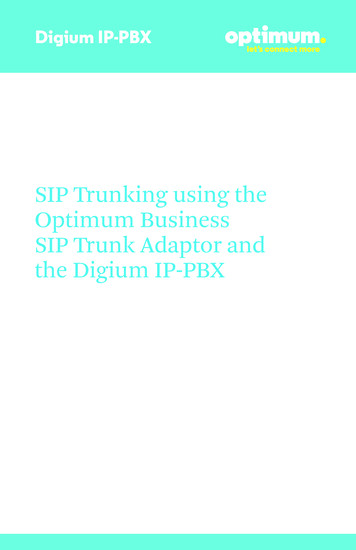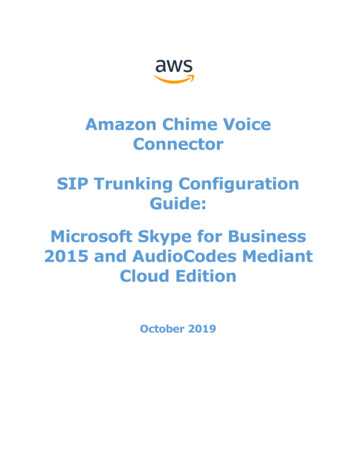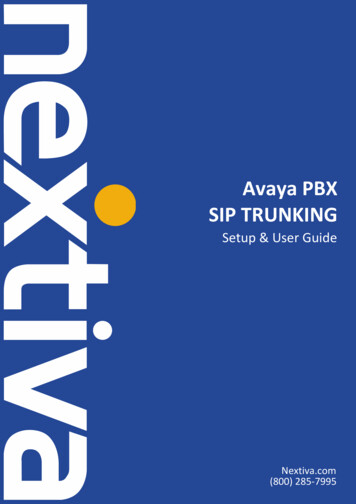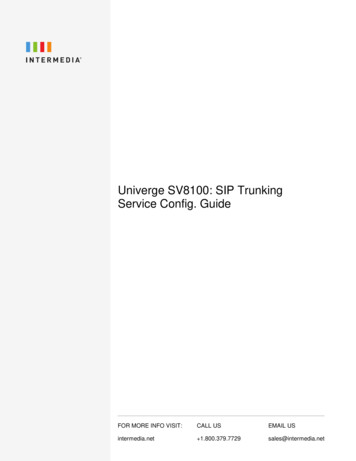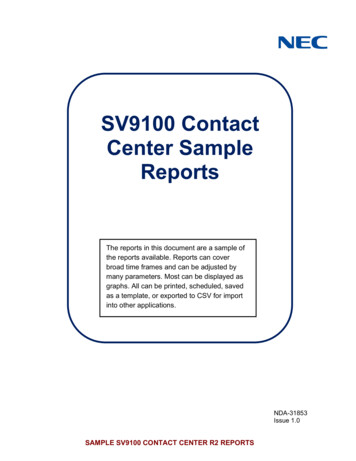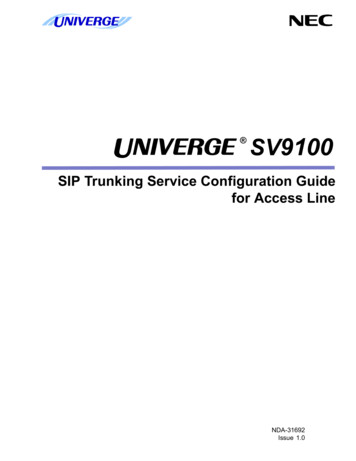
Transcription
SV9100SIP Trunking Service Configuration Guidefor Access LineNDA-31692Issue 1.0
NEC Corporation of America reserves the right to change the specifications, functions, or features atany time without notice.NEC Corporation of America has prepared this document for use by its employees and customers.The information contained herein is the property of NEC Corporation of America and shall not bereproduced without prior written approval of NEC Corporation of America.UNIVERGE is a registered trademark of NEC Corporation. All other brand names and product namesreferenced in this document are trademarks or registered trademarks of their respective companies.Copyright 2015NEC Corporation of America6535 N. State Highway 161Irving, TX 75039-2402Communications Technology Group
TABLE OF CONTENTSSection 1Section 2NEC SV9100 and Access Line Setup Guide . 11.1This Guide and Related Documents . 11.2Access Line Account . 11.3SV9100 System Software . 11.4Requirements . 21.5General Information . 21.6Limitations . 2NEC PBX Configuration. 32.1Section 3Prerequisites . 32.1.1SIP Trunking Information from Access Line . 32.1.2NEC UNIVERGE SV9100 . 32.1.3Installation Worksheet . 3SV9100 Programming . 53.1Trunk Type / Slot Configuration . 53.2GCD-CP10 Network Setup . 83.3VoIP DSP License Assignment . 93.4IPL DSP Basic Setup . 103.5SIP System Information Setup . 123.6SIP Server Information Setup . 133.7SIP Trunk Registration Information . 153.8IP System Interconnection Setup . 163.9Calling Party Information (Trunk) . 173.10Class of Service Options (Outgoing Call Service) . 18SIP Trunking Service Configuration Guidei
Issue 1.0Access LineSection 43.11IP Trunk Calling Party Number Setup . 193.12IP Trunk (SIP) Calling Party Number Setup for Extensions . 203.13DID (TN to ext map) . 213.14SIP Trunk CODEC Setup . 223.15ToS Setup . 233.16SIP Trunk Basic Setup . 24Initial Testing and Troubleshooting. 27iiTable of Contents
LIST OF FIGURES and tablesTable 1Installation Worksheet . 4Figure 1Blade Configuration . 5Figure 2IPL DSP Resource Selection . 6Figure 3IP Trunk Availability . 7Figure 4GCD-CP10 Network Setup . 8Figure 5Blade License Setup . 9Figure 6IPL DSP Basic Setup . 10Table 2Port Table (UDP) . 11Table 3Router Forwarding (Gateway Table) . 11Figure 7SIP System Information Setup . 12Figure 8SIP Server Information Setup . 13Figure 9SIP Trunk Registration Information . 15Figure 10IP System Interconnection Setup . 16Figure 11Class of Service Options (Outgoing Call Service) . 18Figure 12IP Trunk (H.323/SIP) Calling Party Number Setup for Trunks . 19Figure 13Trunk (SIP) Calling Party Number Setup for Extensions . 20Figure 14Incoming Call Trunk Setup . 21Figure 15SIP Trunk Codec Information Basic Setup . 22Figure 16ToS Setup . 23Figure 17SIP Trunk Basic Setup . 24Figure 18FAX over IP Setup . 25Figure 19VoIPDB DTMF Setup - DTMF Relay Mode . 26SIP Trunking Service Configuration Guideiii
Issue 1.0Access LineTable 4Troubleshooting Guide . 28ivList of Figures and Tables
Configuring NEC SV9100 with Access LineSIP Trunking ServiceSECTION 1NEC SV9100 AND ACCESS LINE SETUP GUIDEThis Guide and Related DocumentsThis guide was created to assist knowledgeable vendors withconfiguring the NEC SV9100 Communication Server with Access LineSIP Trunking Service. It provides sample entries for the requiredfields. The actual data is provided by Access Line when service isactivated. Questions about software and hardware installation or otherPBX configuration issues should be directed to NEC’s NationalTechnical Assistance Center (NTAC).Access Line1.1For complete details on using SIP trunks with the SV9100, refer to theSV9100 Networking Manual.For complete details on using DID features, refer to the DID feature inthe SV9100 Features and Specifications Manual.For details about related hardware, refer to the SV9100 SystemHardware Manual.These manuals can be downloaded from NEC’s National TechnicalAssistance Center (NTAC) web site. You must have a valid dealer IDto access the documents.1.2Access Line AccountContact your Access Line representative.1.3SV9100 System SoftwareThe SV9100 requires system software Version 1.70 or higher to useAccess Line service.SIP Trunking Service Configuration Guide1
Issue 1.0Access Line1.4RequirementsWith the SV9100, a VoIP gateway daughter board is required in addition tolicensing for IP (SIP) trunks.A minimum of four IP (SIP) trunks are required due to the NEC CommunicationsServer infrastructure setup.The system software for the NEC Communications Server should beVersion 1.70 or higher.NEC recommends that the requirements and programming are completed with asmuch information as possible before scheduling an activation appointment withAccess Line.1.51.6General Information Emergency 911/E911 Services Limitations and Restrictions - AlthoughSIP Trunk carrier may provide 911/E911 calling capabilities, the SIPTrunk carrier does not warrant or represent that the equipment andsoftware (e.g., IP PBX) reviewed in this customer configuration guide willproperly operate with Carrier to complete 911/E911 calls; therefore, it isthe customer’s responsibility to ensure proper operation with itsequipment/software vendor. A SIP Trunk carrier services support E911/911 calling capabilities undercertain Calling Plans, there are circumstances when that E911/911service may not be available. Such circumstances include, but are notlimited to, relocation of the end-user’s CPE, use of non-native or virtualtelephone number, failure in the broadband connection, loss of electricalpower, and delays that may occur in updating the customer’s location inthe automatic location information database.LimitationsThe following limitations apply: Some private IP network ranges conflict with SIP trunking serviceproviders ranges. This can cause issues when connecting to the SIPtrunking service provider. Private ranges reserved for the customer’sLAN are:10.x.x.x192.168.0.x through 192.168.10.x2 SIP Diversion header not supported. SIP REFER not supported.SIP Trunking Service Configuration Guide
Access LineSECTION 2Issue 1.0 Secondary SIP server for failover not supported. Network-based call forward, call transfer, sequential ringing, andsimultaneous ringing not supported. The interop tested was completed with Non-Registration SIP Trunks,and SIP Profile 1.NEC PBX CONFIGURATIONThis section provides information to NEC’s solution providers and NEC Associates forconfiguring an NEC UNIVERGE SV9100 to connect to a Access Line SIP Trunkservice provider, utilizing a DYNAMIC configuration.2.1PrerequisitesBefore you configure the UNIVERGE SV9100, you must have the followinginformation available.2.1.12.1.22.1.3SIP Trunking Information from Access Line Primary SIP Proxy Server IP Address. Number Plan, if applicable for the Point-to-Point Connection. Trunking DID(s)The DID(s) are forwarded to the Public WAN IP address(s),DNS or DNS SRV records of the PBX.NEC UNIVERGE SV9100 SV9100 CPU firmware Version 1.70 or higher GPZ-IPLE Digital, IP and TDM Telephones R1 Version License (0411) System Port License (0300) VoIP Resource License (5301) IP Trunk License (5001)Installation WorksheetUse the worksheet to record the information needed for setting upthe SIP Trunking service.SIP Trunking Service Configuration Guide3
Issue 1.0Access LineTable 1 Installation WorksheetWAN Side:Internet Access Type and Speed:WAN IP Address:WAN Subnet Mask:WAN Gateway IP Address:LAN Side:LAN IP Address for SIParator or EdgeMarc:LAN Subnet Mask:LAN IP Address for SV9100:VLAN ID:PBX Information:Model:Firmware Version:Number of SIP Trunk Licenses:Add-on Software Applications:Number of Users:Number of Concurrent Calls:Notes:4SIP Trunking Service Configuration Guide
Access LineSECTION 3Issue 1.0SV9100 PROGRAMMINGWhen using Access Line as your SIP trunking service provider, the followingprograms must be changed for SIP trunking service.When using PCPro or WebPro for programming, enabling an option may be acheckbox option rather than entering a ‘1’ as in terminal programming.3.1Trunk Type / Slot ConfigurationFigure 1 Blade ConfigurationSIP Trunking Service Configuration Guide5
Issue 1.0Access LineFigure 2 IPL DSP Resource Selection10-19-01 : VOIP DSP Resource SelectionSpecify the operating mode for the DSP resources (0 common use (extensionsand trunks), 1 IP extensions only, 2 SIP trunks only, 3 Networking, 4 NetLink,5 Blocked, 6 Common without Unicast Paging, 7 Multicast, 8 Unicast Paging).6SIP Trunking Service Configuration Guide
Access LineIssue 1.0Figure 3 IP Trunk Availability10-68-01 : IP Trunk Availability – IP Trunk AvailabilityAssign the trunk type as SIP.10-68-02 : IP Trunk Availability – Start PortAssign the Starting Port for the SIP Trunks.10-68-03 : IP Trunk Availability – Number PortAssign the number to SIP Trunk Ports.SIP Trunking Service Configuration Guide7
Issue 1.0Access Line3.2GCD-CP10 Network SetupValues shown are for example purposes only. Your actual IP values will bedetermined by your local LAN administrator.Figure 4 GCD-CP10 Network Setup10-12-01 : GCD-CP10 Network Setup – IP AddressSet the LAN IP address for the system Ethernet port to 0.0.0.010-12-02 : GCD-CP10 Network Setup – Subnet MaskSet the subnet mask for the system Ethernet port to be different than the subnetfor the IPLE blade.10-12-03 : CCD-CP10 Network Setup – Default GatewaySet the default gateway for the IPLE blade.8SIP Trunking Service Configuration Guide
Access LineIssue 1.0If a router or firewall is placed between the SIP Trunk Provider and SV9100,you must also set the following programs: All routing and forwarding is done by the Starbox Lite router, so NAPT should not beneeded in the SV9100.10-12-07 : CD-CP00 Network Setup – NAPT Router IP AddressSet the WAN IP address of the NAT router behind the SV9100. NAT Router mustalso be enabled in PRG 10-29-21.10-12-09 : CD-CP00 Network Setup – IP AddressSelect the IP address for the VoIP connection (default: 172.16.0.10). A static IPaddress is required.The SV9100 must be reset in order for the change to take effect.10-12-10 : CD-CP00 Network Setup – Subnet MaskSelect the Subnet Mask to be used by the VoIP server (default: 255.255.0.0).3.3VoIP DSP License AssignmentValues shown are for example purposes only. Your actual License quantitywill be determined by the License File loaded to GCD-CP10.Figure 5 Blade License Setup10-54-01 : Blade License Setup – CodeAssign License Code 5103 (VoIP DSP Channel)10-54-02 : Blade License Setup – QuantityAssign the quantity of VoIP DSP Channel Licenses (5103) The License quantity can be found on Feature Activation Page.SIP Trunking Service Configuration Guide9
Issue 1.0Access Line3.4IPL DSP Basic SetupValues shown are for example purposes only. Your actual IP values will bedetermined by your local LAN administrator.Figure 6 IPL DSP Basic SetupPort Forwarding:The Router will require port forwarding rules to be configured.Port 5060 must be forwarded to the address entered in Program 10-12-09.Port 5060 is not used for remote terminals - ports 5070 and 5080 are usedinstead. Port 5060 is only used for trunking so there are no issues with thepossible fraudulent usage of unauthorized remote attempts to register remoteterminals.The ports used in Programs 84-26-02 and 84-26-03 must be forwarded to theIP address entered in Program 84-26-01.The RTP/RTCP ports are forwarded to avoid possible one-way conversationwhich might occur on inbound calls. The Port Forwarding Range is determined byhow many VoIP DSP Resources are licensed to the GCD-CP10. This informationcan found on the Feature Activation screen in WebPro, and is the same quantitythat was entered in PRG 10-54 for feature code 5103.10SIP Trunking Service Configuration Guide
Access LineIssue 1.0Table 2 Port Table (UDP)IPLE Licensed ChannelsBegin PortEnd 4712810020102752561002010531Table 3 Router Forwarding (Gateway Table)IPLEIP AddressRTP PortRTCP PortUDPIPLEExample: Router configuration shown from the NEC InRouter/4300T Routerudp;143.101.120.218/255.255.255.0-10020 -10021 -10052 -10053 -10084 -10085 -10116 -10117 -5060 172.16.0.10-5060SIP Trunking Service Configuration Guide11
Issue 1.0Access Line3.5SIP System Information SetupValues shown are for example purposes only. Your actual values will bedetermined by your implementation team.Figure 7 SIP System Information Setup10-28-01 : SIP System Information Setup – Domain NameDefine the Domain name up to 64 characters. This information is specific to yourmarket and is provided by your SIP Trunking Service Provider. When configuring Domain name, the SIP service provider will supply the Proxy/Domainin the following manner - "Host Name" . "Domain Name" . The characters are normallyseparated by “.” The characters after “.” will be in the Domain Name.10-28-02 : SIP System Information Setup – Host NameDefine the Host name, up to 48 characters. When configuring Host name, the SIP service provider will supply the Proxy/Domain inthe following manner - "Host Name" . "Domain Name" . The characters are normallyseparated by “.” The characters before “.” will be in the Domain Name.10-28-03 : SIP System Information Setup – Transport ProtocolDefine the Transport type. This option is always set to 0 (UDP).10-28-05 : SIP System Information Setup – Domain AssignmentDetermine the type of Domain Assignment. Set this entry to 0 (IP Address).10-28-06 : SIP System Information Setup – IP Trunk Port BindingSet this entry to 0 (Disable) to allow an incoming call to use the lowest port.12SIP Trunking Service Configuration Guide
Access LineIssue 1.03.6SIP Server Information SetupValues shown are for example purposes only. Your actual values will bedetermined by your implementation team.Figure 8 SIP Server Information SetupSIP Trunking Service Configuration Guide13
Issue 1.0Access Line10-29-01 : SIP Server Information Setup – Outbound Default ProxyEnable (1) the SIP Outbound Proxy. If entries are made in Program 10-29-xx for a SIP Server and the SIP Server is then removedor not used, the entries in Program 10-29-xx must be set back to their default settings. Evenif 10-29-01 is set to .0. (off), the SV9100 will check the settings in the remaining 10-29programs.10-29-03 : SIP Server Information Setup – Default Proxy IP AddressDefine the SIP Trunk Service Provider Proxy IP Address. You may resolve the IPaddress of the Outbound Proxy by pinging the URL.10-29-05 : SIP Server Information Setup – Registrar ModeSet the Registrar Mode to 0 (None) with SIP trunking.10-29-06 : SIP Server Information Setup – Registrar IP AddressInput the IP address of the SIP registrar (if given).10-29-11 : SIP Server Information Setup – SIP Proxy Setup – RegistrarDomain NameDefine the Registrar Domain Name. This information should be provided by yourSIP service provider (128 characters maximum).10-29-12 : SIP Server Information Setup – Proxy Domain NameEnter the Domain name. When configuring the Domain name, the SIP service provider will supply the Proxy/Domain in the following manner - "Host Name" . "Domain Name" . The characters arenormally separated by “.” The characters after “.” will be in the Domain Name.10-29-13 : SIP Server Information Setup – Proxy Host NameEnter the Host name. When configuring Domain name the SIP service provider will supply the Proxy/Domain inthe following manner - "Host Name" . "Domain Name" . The characters are normallyseparated by “.” The characters before “.” will be in the Host Name.10-29-14 : SIP Server Information Setup – SIP Carrier ChoiceSet the SIP Carrier Choice to 2 (Carrier B).10-29-15 : SIP Server Information Setup – Registration Expiry TimeIt is important to leave this automatic re-registration time to be 3600 seconds sothat the Access Line networ
The interop tested was completed with Non-Registration SIP Trunks, and SIP Profile 1. SECTION 2 NEC PBX CONFIGURATION This section provides information to NEC’s solution providers and NEC Associates for configuring an NEC UNIVERGE SV91
